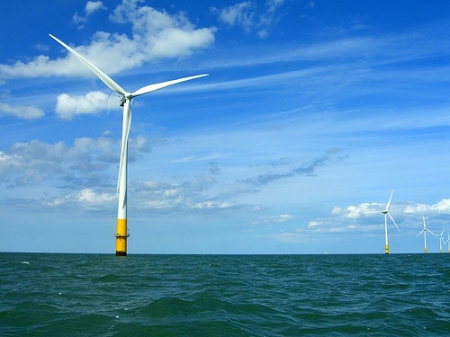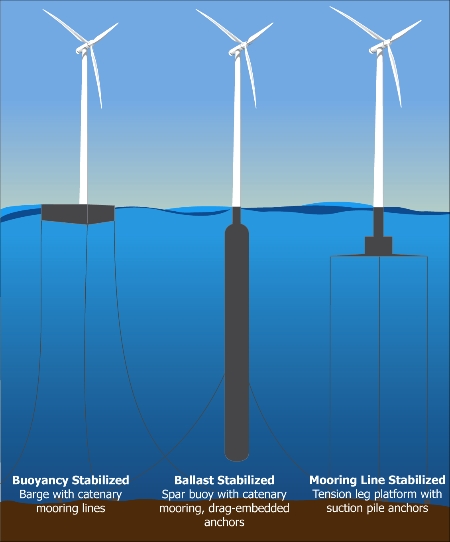New Hampshire, USA — Researchers at the University of Maine’s DeepCwind Consortium have been working to make the goal of having 5 GW of offshore wind a reality by 2030 . With more than $1 million in grant funding provided by the Department of Energy (DOE), their first task is figuring out how to construct a cost- and energy-efficient deep offshore wind turbine.
At EnergyOcean International 2011, Dr. Christopher G. Hart, Offshore Wind manager at the DOE, expressed enthusiasm for the DeepCwind project. “We are excited at the Department of Energy to find a cost optimum system and the possibilities that deepwater offshore presents,” he said.
To determine turbine placement, researchers are conducting extensive testing at their pre-permitted deepwater offshore wind testing site, located three miles south of Monhegan Island. Here, they assess turbine platforms, wind resources, ecological resources and geophysical and wave conditions.

The DeepCwind project is organized in five phases. Phase 1 (2010-2012) involves the design and testing on a 1:3 scale a floating turbine at the Monhegan test site. Phase 2 (2011-2015) involves the design and deployment on a full-scale floating turbine prototype. And during phases 3-5, researchers hope to build 4-8 floating offshore wind farms 10-50 miles offshore with a total capacity of 4 GW. The project should be completed by 2030.
Platform Design
One of the major challenges for harnessing offshore wind is structural costs and design of the turbines. Many offshore platforms are massive and extremely expensive. With this in mind, researchers held a design competition to determine the best offshore turbine platform designs.

Three designs were chosen: buoyancy stabilized, ballast stabilized and mooring line stabilized. According to consortium, the buoyancy platform consists of a barge base with catenary mooring lines. These lines form a curved shape and raise the resistance of the anchors. Ballast platforms include a spar buoy (tall, thin buoy noted for its balance), catenary mooring, and drag-embedded anchors. Mooring line platforms consist of a tension leg platform with suction pile anchors.
Grid Connectivity
DeepCwind experts also must consider grid connectivity in relation to the placement of the offshore turbines. According to its Offshore Wind Report, “interconnection sites were evaluated based on their relative grid stiffness, general readiness to accept up to 30 MW of wind generation and their location relative to the proposed wind project areas of interest.” Researchers rejected any interconnection site more than 60 km from the proposed project site, any site with a stiffness ratio of less than 5:0 or sites that were unable to handle 30 MW. Four sites were determined viable along the Maine shore.
Researchers then studied these sites further during summer peak hours to determine viability. According to the report, “the general conclusion reached from the cursory assessment is that the interconnection of up to 30 MW at any of the sites identified above is not expected to have an adverse impact on thermal or voltage related issues on the CMP medium or high voltage transmission system.” The report also gives cabling cost estimates of around $65-75 per foot for aerial lines and $300-400 per foot for underground lines. Researchers are also investigating common connection concerns including waves, sediments and currents, along with methods that could mitigate these issues.
Environmental Concerns
Environmental experts have been involved with the project to determine risk factors. Several species that are threatened include migratory birds, bats, endangered marine animals, fish habitats and coastal wildlife. Experts have taken special care in avoiding high-risk areas for these species. Wind turbines are one of the least dangerous areas of concern for birds, accoriding to Jeff Thaler, a lawyer at Bernstein Shur. Thaler spoke bluntly at EnergyOcean: “Each year, wind turbines kill 28,500 birds, pesticides kill 67 million, cars kill 80 million, power lines kill 550 million — and the common cat kills over 180 million birds.”
Upcoming Plans
In October 2011, a new offshore wind lab will be opening at the University of Maine. According to the lab’s website, it “will include a nanocomposites laboratory, a large structural testing laboratory with a test stand capable of supporting a 70-meter wind blade, and space to accommodate faculty, staff, and graduate researchers.” The full-scale deepwater wind prototype is planned to be launched from July-October 2012 to collect new data. At EnergyOcean International, both Dr. Hart and Dr. Habib J. Dagher, P.E. Director of DeepCwind, agreed, “the key is not to be the first in the water, but the smartest.” Step by step, DeepCwind slowly moves closer to that goal.
 Follow
Follow